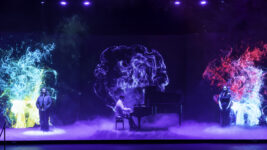News
23 Dec 2016
My Fair Lady’s Audio Makeover

Subscribe to CX E-News
After a record-breaking premiere at the Sydney Opera House, the recreation of the 1956 Broadway production of My Fair Lady travels to Brisbane, Melbourne and Sydney’s Capitol Theatre in 2017.
In honour of My Fair Lady’s 60th Anniversary, GFO and Opera Australia recruited the original Eliza Doolittle, Dame Julie Andrews, to direct this landmark production. The sets, costumes and lighting are based on the original 1956 design with a few more up-to-date touches, like seamless revolving stages and automated lighting.
Of course it would have been silly to try recreate the original audio design and so Michael Waters was appointed to give it a welcome 21st century makeover with JPJ Audio’s assistance.
“We did see the original audio spec for the 1956 production which was only one page,” said Michael. “The sound pre-show check was ‘turn on an amplifier, have the reel to reel wound back to such a counter point and then press play at this time’. That was it!”
It was up to Michael to respect the intent of the original audio for the show whilst satisfying the modern audience who have a totally different perception and expectation of audio these days.
Apparently Dame Julie was very excited to learn that Michael could introduce surround sound which bought a whole new world to the production.
“I was able to occasionally produce some soundscapes throughout the show,” commented Michael, who was mixing on a DiGiCo SD10 console. “It’s not a sound effect heavy show but it does have its moments where you can have some fun – especially the Ascot horse race!”
Michael describes the Dame Joan Sutherland theatre as a rather dead space (dry as a nun’s proverbial were his exact words) once the audience is seated and so to liven it up, he employed some subtle reverbs around the room to fill out the space.
“It’s such a funny piece with lots of comedic lines in the show and when the audience erupts into laughter, it would be easy to miss the subsequent dialogue,” Michael noted. “Being amplified we could push over the sound of the laughter and that also encourages the audience to keep laughing without fearing they’ll miss the next line.”
The PA was a mixture of L-Acoustics KIVA for the centre cluster, SB18’s for subs, 5XT’s for surrounds and delays, Meyer MSL-2 speakers for the dress circle and god’s proscenium, and Meyer UPM-2’s for front fill.
“I chose the UPM-2 speakers for their narrow 45 degree dispersion as the orchestra are not used to sitting in front of speakers,” explained Michael. “As the UPM-2’s are directional, they fire over their heads.”
Whilst the orchestra microphones are wide and varied, the cast are on DPA 4061 miniature omnidirectional microphones on Shure UR1M micro-bodypack transmitters.
“I think we kept true to the intent of the show,” he said. “It wasn’t over-amplified, it was just enough for every audience member to hear it clearly all the way to the Gods at the back of the circle, and make the orchestra sound dynamic throughout the theatre.”
Subscribe
Published monthly since 1991, our famous AV industry magazine is free for download or pay for print. Subscribers also receive CX News, our free weekly email with the latest industry news and jobs.





